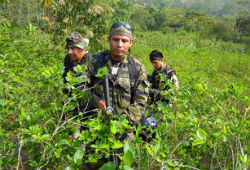Colombia has surpassed Peru in coca cultivation, according to a new United Nations report, and may have reclaimed its title as the world’s top cocaine producer.
Colombia and Peru’s flip-flop as the world’s largest supplier of coca is due to sharply contrasting trends in cultivation. With an estimated 42,900 hectares of coca grown in 2014, Peru registered a 14 percent decline from the previous year, according to a new report (pdf) by the United Office on Drugs and Crime (UNODC). Meanwhile, the UNODC recently calculated coca cultivation in Colombia jumped to 69,000 hectares last year, a 44 percent increase from 2013.
Coca cultivation in Peru has been falling since 2011, when it reached a peak of 62,500 hectares. That year, the US government declared Peru was the world’s top producer of cocaine, which was later confirmed by the UNODC in 2013.
The reduction in coca crops has coincided with stepped-up eradication efforts by Peruvian authorities, with US support. Last December, government officials said they uprooted over 31,000 hectares of coca in Peru during 2014, the second consecutive year of record levels of eradication.
However, due to security risks Peru does not eradicate coca in the Apurimac, Ene and Mantaro River Valleys (VRAEM). The triple-valley region is by far Peru’s biggest coca-growing zone and a stronghold of left-wing guerrilla group the Shining Path. Cultivation in the VRAEM remained relatively stable in 2014, and represented 44 percent of all coca grown in the country (see UNODC chart below).
The Aguaytia and Alto Huallaga regions saw the sharpest decline in coca cultivation last year, with both registering over a 60 percent decrease from 2013 levels. The Kcosñipata region in eastern Peru experienced the most significant expansion of coca crops, which the UNODC said was due to increased demand for cocaine paste that is smuggled across the border into Bolivia and later sent to Brazil.

InSight Crime Analysis
The UNODC report does not provide an estimate for Peru’s potential cocaine yield, but the data suggests Colombia may once again be the world’s top producer of the illicit drug. This is not certain despite Colombia overtaking Peru in cultivation, since Peruvian coca is capable of producing more cocaine than the crops found in Colombia, which are younger and have lower alkaloid content.
Nonetheless, Colombia’s coca crops now outnumber those in Peru by a significant margin — over 30 percent, according to UNODC figures. What’s more, is it highly possible the UNODC is underestimating the amount of coca grown in Colombia. Due to years of aerial fumigation, Colombian farmers mix coca with other crops and plant smaller fields, making it difficult for the UNODC’s satellite imaging system to detect some areas of cultivation. Colombian coca crops can also be harvested up to six times per year, double the average number of yields in Peru.
SEE ALSO: Coverage of Coca
Diverging trends in eradication is one of the main factors that has enabled Colombia to outstrip Peru in coca cultivation. While eradication has reached record levels in Peru, the number of coca crops destroyed in Colombia has been falling steadily since the late 2000s. The recent decision by the Colombian government to end aerial fumigation may only exacerbate this pattern, since as much as 70 percent of all coca crops are sown in areas controlled by left-wing guerrilla group the Revolutionary Armed Forces of Colombia (FARC). For security reasons, the manual eradication of coca is extremely difficult in FARC territory. The FARC are also keen to keep coca cultivation high, as it gives them greater leverage in the ongoing peace negotiations with the government.
These dynamics suggest coca cultivation — and by extension, cocaine production — will continue to increase in Colombia during 2015. Sources on the ground have previously told InSight Crime cultivation is keeping pace with last year or even accelerating, and less eradication means more mature crops that yield a higher amount of cocaine.
In Peru, the impressive eradication results are linked to the government’s success in combating the Shining Path, which both regulates and protects the coca market. Following the arrest of rebel leader Florindo Eleuterio Flores Hala, alias “Artemio,” in February 2012, eradicators were able to penetrate his stronghold in the Monzon Valley, which is located in the Alto Huallaga region. This led to a nearly ten-fold reduction in the region’s coca crops between 2012 (9,509 hectares) and 2014 (1,555 hectares).
SEE ALSO: Peru News and Profiles
However, authorities have yet to penetrate the VRAEM, which doubles as the Shining Path’s last remaining stronghold and the country’s most prolific coca-growing region. Peru abandoned its eradication program in the VRAEM last June due to security risks posed by the Shining Path, and the government’s alternative strategy — a crop substitution plan — has so far failed to produce results. If authorities hope to reduce coca cultivation in the VRAEM as it did in the Alto Huallaga, they will almost certainly have to break the Shining Path’s grip on the region.
Peru’s success or failure in claiming control of the VRAEM will be decisive in the government’s ongoing fight against international drug trafficking and narco-corruption. An estimated 200 tons of cocaine is produced every year in the remote jungle region, much of which supplies the cocaine air bridge that connects Peru to Brazil via Bolivia. This fact recently prompted one prominent politician to claim Peru is at risk of becoming a narco-state.

